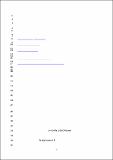Por favor, use este identificador para citar o enlazar a este item:
http://hdl.handle.net/10261/215244COMPARTIR / EXPORTAR:
 SHARE SHARE
 CORE
BASE CORE
BASE
|
|
| Visualizar otros formatos: MARC | Dublin Core | RDF | ORE | MODS | METS | DIDL | DATACITE | |

| Título: | From hydroplastic to brittle deformation: Controls on fluid flow in fold and thrust belts. Insights from the Lower Pedraforca thrust sheet (SE Pyrenees) |
Autor: | Cruset, David CSIC ORCID CVN ; Cantarero, Irene; Benedicto, Antonio; John, Cédric M.; Vergés, Jaume CSIC ORCID ; Albert, Richard; Gerdes, A.; Travé, A. | Palabras clave: | Fold and thrust belts Clumped isotopes Fluid flow Hydroplastic and brittle deformation U–Pb calcite dating |
Fecha de publicación: | jun-2020 | Editor: | Elsevier | Citación: | Marine and Petroleum Geology, 120: 104517 (2020) | Resumen: | We present a multidisciplinary study to decipher the controls of deformation on fluid flow regime in fold and thrust belts using the Lower Pedraforca thrust sheet in the SE Pyrenees as an example. We integrate field-based and petrographic observations and geochemical and geochronological data to differentiate seven types of fractures, eight types of calcite cement (Cc1 to Cc8) and two sets of stylolites during the deformation stretching the studied thrust sheet. During syn-sedimentary hydroplastic normal faulting affecting poorly consolidated Upper Cretaceous and Eocene syn-orogenic sediments, calcite cement did not precipitate. During burial, bed-parallel stylolites formed and Cc1 and Cc2 precipitated from formation waters in a closed palaeohydrological system. During the layer-parallel shortening, Cc3 precipitated from formation waters (~+5.4‰ VSMOW) with 87Sr/86Sr ratios of 0.707922 and at ~70 °C. Cc4 precipitated from formation waters recording different burial conditions, as the up to 4‰ dispersion in δ18O of this cement suggests. Contrarily, during folding and thrusting, Cc5 to Cc7 precipitated in an open palaeohydrological system. Cc6 precipitated from formation waters (~+5‰ VSMOW), with 87Sr/86Sr ratios of 0.707817 and at ~75 °C. These fluids carried hydrocarbons and probably interacted with Upper Triassic evaporites. An 87Sr/86Sr ratio of 0.708230 for Cc5 indicates that formation waters also interacted with clays within continental deposits. During this period, stylolites formed in relation to faulting, and previous hydroplastic normal faults reactivated as reverse and strike-slip faults allowing fluid flow. Cc7 precipitated after Cc6, also from fluids in isotopic disequilibrium with their adjacent host rock. The fluid system continued open during the Oligocene, when Cc8 precipitated in normal faults affecting syn-orogenic conglomerates deposited during the reactivation of the Lower Pedraforca thrust sheet. The influence of deformation on fluid flow observed in the Lower Pedraforca thrust sheet is similar to that observed in other fractured areas worldwide. | Versión del editor: | https://doi.org/10.1016/j.marpetgeo.2020.104517 | URI: | http://hdl.handle.net/10261/215244 | DOI: | 10.1016/j.marpetgeo.2020.104517 | ISSN: | 0264-8172 | E-ISSN: | 1873-4073 |
| Aparece en las colecciones: | (Geo3Bcn) Artículos |
Ficheros en este ítem:
| Fichero | Descripción | Tamaño | Formato | |
|---|---|---|---|---|
| Verges_Marine and Petroleum Geology_120_104517_postprint.pdf | 3,77 MB | Adobe PDF |  Visualizar/Abrir |
CORE Recommender
SCOPUSTM
Citations
16
checked on 18-abr-2024
WEB OF SCIENCETM
Citations
15
checked on 24-feb-2024
Page view(s)
214
checked on 23-abr-2024
Download(s)
60
checked on 23-abr-2024
Google ScholarTM
Check
Altmetric
Altmetric
Este item está licenciado bajo una Licencia Creative Commons

